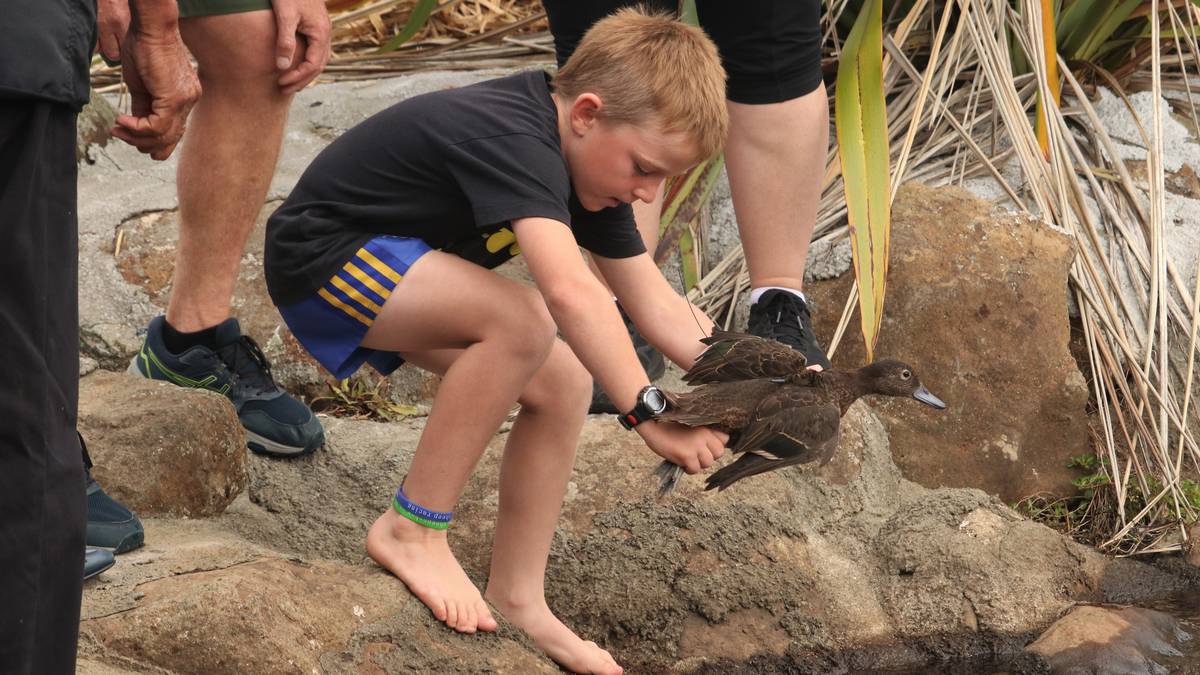Six-year-old Riley Nilsson, from Bay of Islands International Academy in Te Tii, releases a pāteke into its new home. Photo / Peter de Graaf
One of the world’s rarest ducks has been given a new home in the Bay of Islands, where it is hoped a new generation of ducklings will start hatching next spring.
A crowd of locals, school children, conservation workers, councillors and iwi members gathered at The Landing on Purerua Peninsula about 30 kilometres northeast of Kerikeri earlier this month to release 20 pāteke at a small bush-fringed lake.
The release was organised by conservation group Kiwi Coast and made possible by a massive effort from Pest Free Purerua, which has removed 11,000 pests from the peninsula in the past three years.
Kiwi Coast Mid North co-ordinator Andrew Mentor said pāteke, also known as brown teal, once numbered in the hundreds of thousands and were found in every corner of New Zealand.
Advertisement
However, pāteke were extremely vulnerable to introduced predators, and as a result their numbers plummeted to just 700 by the 1990s.
Their small size — half that of the introduced mallard duck — and nocturnal habits made them easy prey for cats and mustelids (stoats, weasels and ferrets), but also for pūkeko and hawks.
Since the national Pāteke Recovery Programme started more than 20 years ago, their numbers had increased to about 2000.
However, it was still one of New Zealand’s rarest waterfowl, roughly on par with the whio/blue duck, and it was the world’s fourth-rarest dabbling duck (a type of duck that frequents shallow waters and feeds by tipping up rather than diving).
Advertisement
The 20 ducks released at Purerua represented 1 per cent of the planet’s pāteke population.
Mentor said it was well worth trying to preserve the rare birds.
“If we were to lose another species when we can do something about it, that would be a tragedy. It’s our responsibility to do what we can to keep them surviving and thriving.”
/cloudfront-ap-southeast-2.images.arcpublishing.com/nzme/FPG2KJDQDVE4XDJX55MFZGU7RU.jpg)
Earlier attempts to reintroduce pāteke to the peninsula in 2011-15 had failed.
That was because predator control wasn’t continued at that time, allowing feral cats to kill most of the rare ducks.
Predator control now met the strict standards required by the Department of Conservation’s (DoC) Pāteke Recovery Group, he said.
The highly travelled ducks were reared in captivity at various locations around New Zealand, then transported to Christchurch for health checks and the fitting of radio transmitters.
On Monday, they were flown to Kerikeri in five duck crates and taken by road to the release site.
All 20 pāteke were descended from birds that clung to survival at Aotea (Great Barrier Island) and Mimiwhangata, north of Whangārei, so they were escorted to the release site by members of coastal iwi Ngātiwai and handed over to local hapū Ngāti Torehina.
They were released at a small lake with three feeders identical to those used at their Christchurch home, to encourage them to stay close by while they adjusted to their new surroundings.
Advertisement
The feed supply would be gradually reduced until they reverted to wild ducks feeding on insects, seeds, fruit, grass and leaves.
/cloudfront-ap-southeast-2.images.arcpublishing.com/nzme/PFUZ4Z6SEFA63HIP2F4H6DGPNQ.jpg)
Among those given the chance to release a pāteke was Lavinia Hilliger, an exchange student from Germany staying with a Purerua family.
It was “pretty exciting” to hold such a rare bird, the 16-year-old said.
“It was cute and pretty, and very soft,” she said.
Mentor said daily monitoring of the pāteke would continue for six weeks, which would immediately alert Kiwi Coast to any problems or losses.
Less frequent monitoring would continue for the rest of the year, along with intensive predator control.
Advertisement
It was hoped the birds would pair up and start breeding next spring.
The aim of Kiwi Coast’s Pest Free Purerua Project was to remove all feral cats, possums, mustelids and rats from the peninsula within the next two years.
Mentor said rats would be the hardest to get rid of.
“We will suppress them as far as we can. But ultimately, we’re looking to the Predator Free 2050 programme to give us some new tools to take them to eradication.”
Pāteke facts
- The pāteke (brown teal) is about half the size of the introduced mallard duck, with dark brown plumage, a distinctive white ring around the eyes and green feathers under the wings.
- Pāteke almost became extinct in the 1990s when only 700 remained, mostly on Great Barrier Island and along Northland’s east coast.
- Numbers have recovered to about 2000 since then, but the pāteke remains the world’s fourth-rarest dabbling duck.
- Their small size and nocturnal habits make them highly vulnerable to predators, especially cats and mustelids (stoats, weasels and ferrets).
- Other species of duck found only in New Zealand include the scaup/pāpango, the paradise shelduck/pūtangitangi, the shoveler/kuruwhengi, and the blue duck/whio, which lives exclusively in fast-flowing mountain streams.
/cloudfront-ap-southeast-2.images.arcpublishing.com/nzme/5G7HG7ZF2BEGBCLCDYGAVETMME.jpg)
/cloudfront-ap-southeast-2.images.arcpublishing.com/nzme/J3UUED6DIBGODJ5EDSZCFPYCMM.jpg)
/cloudfront-ap-southeast-2.images.arcpublishing.com/nzme/CH6WHDKE5VHDLAIHXF7GJNSFFI.jpg)
/cloudfront-ap-southeast-2.images.arcpublishing.com/nzme/G2F6C3EFYBBMTOKRIBMTUTBA5I.jpg)
/cloudfront-ap-southeast-2.images.arcpublishing.com/nzme/GV3WJCJHUNHGPG7JEO67XMUY64.jpg)
/cloudfront-ap-southeast-2.images.arcpublishing.com/nzme/C24NVNIHUNGDNEUZKXZC2ZH5NE.jpg)
/cloudfront-ap-southeast-2.images.arcpublishing.com/nzme/AV44RLFWUVF3TLESABXZI4QQEI.jpg)
/cloudfront-ap-southeast-2.images.arcpublishing.com/nzme/NSAJUB4BEFBBRNINQDL4A66FKU.jpg)



